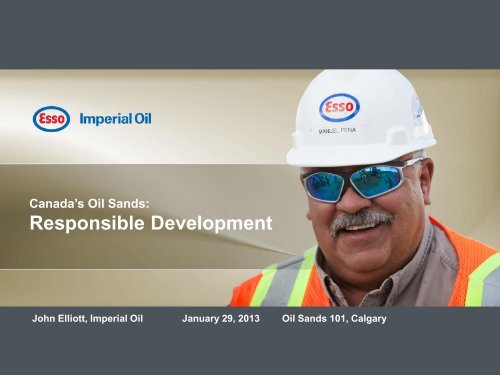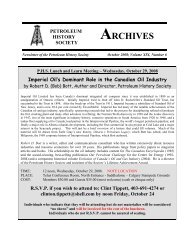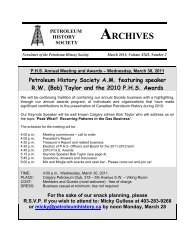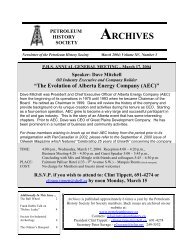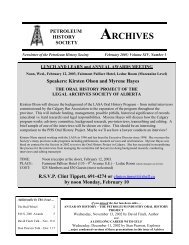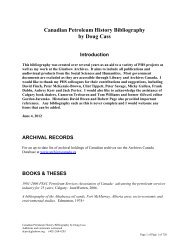Responsible Development - Canadian Association of Petroleum ...
Responsible Development - Canadian Association of Petroleum ...
Responsible Development - Canadian Association of Petroleum ...
You also want an ePaper? Increase the reach of your titles
YUMPU automatically turns print PDFs into web optimized ePapers that Google loves.
Canada’s Oil Sands:<strong>Responsible</strong> <strong>Development</strong>John Elliott, Imperial Oil January 29, 2013 Oil Sands 101, Calgary
Cautionary StatementThis presentation may contain forward-lookinginformation on future production, project start-upsand future capital spending. Actual results coulddiffer materially due to changes in project schedules,operating performance, demand for oil and gas,commercial negotiations or other technical andeconomic factors.
What I’d like to discuss todayEnergy outlookOil sands industry overview, including extraction techniquesOil sands challenges and solutions
Imperial Oil: an integrated operationExplorationWe’re unlocking Canada’s energy resources<strong>Development</strong> and productionWith world-class research and advancedtechnologyMarketingDelivering fuels and products across CanadaRefining and petrochemicalsProducing fuels and products that<strong>Canadian</strong>s need
million barrels per day <strong>of</strong> oil equivalentEnergy demand is increasing…Most energy will continue to come from oil & gasWind, solar & bi<strong>of</strong>uelsBiomass, Hydro & GeoNuclearCoalGasOil
Canada’s oil sands are enormous• Canada has thirdlargest reserves inthe world• Over 97% associatedwith oil sandsSource: U.S. Energy Information Administration• Canada has theopportunity to fillimportant globalenergy supply gaps
Where are the oil sands?• Three areas in northernAlbertaPEACERIVERATHABASCA• Largest: AthabascaEdmontonCOLD LAKECalgary100 mile125 km
Economic benefits across CanadaHigh-quality employment and economic benefitsfor <strong>Canadian</strong>s from coast to coastMap courtesy <strong>of</strong> the <strong>Canadian</strong><strong>Association</strong> <strong>of</strong> <strong>Petroleum</strong> Producers25%$28 billionBritish Columbia4%$5 billionSaskatchewan3%$4 billionManitoba 52%$63 billionOntario13%$14 billionQuebec25 year forecast$30 billionin annualgovernment revenues126,000 jobswill be created outside Alberta$2.1 trillion inGDP over 25 years(CERI 2011)
What are “oil sands”?• Sand saturated with very heavy oil (bitumen)• Bitumen is thick• Heat and water used to produce it
Depth <strong>of</strong> resourcedetermines recovery methodCloser to surface:Mining(20% <strong>of</strong> the oil sands)
Depth <strong>of</strong> resourcedetermines recovery methodDeeper below surface: In-situ (in place)
Understanding the issues• Continue to reduceenvironmental impacts‣ GHG emissions‣ Water use‣ Reclamation‣ Tailings• Challenges can be managed• Research and technologyleadership is our strength
GHG emissionsIssue:Oil sands development results in higher greenhousegas (GHG) emissions than conventional production6%more GHG emissionsfrom oil sands than UScrude supply average6.5%<strong>of</strong> Canada's GHGemissions are fromoil sands
GHG emissionsIssue:Oil sands development results in higher greenhousegas (GHG) emissions than conventional production6%more GHG emissionsfrom oil sands than UScrude supply average6.5%<strong>of</strong> Canada's GHGemissions are fromoil sandsSummary <strong>of</strong> greenhouse gas emissions
Life cycle greenhouse gas emissionsSource: IHS CERA 2012Kilograms <strong>of</strong> CO2 equivalent per barrel <strong>of</strong> refined products
Water useIssue:Oil sands operations require large amounts<strong>of</strong> water for processingThrough more than 40 years <strong>of</strong>technical innovation, Imperial haspioneered state-<strong>of</strong>-the-art waterrecycling technologyWe are steadily reducing theamount <strong>of</strong> water we need~3%<strong>of</strong> the Athabasca Riverflow is allocated; lessthan half used>90%<strong>of</strong> produced waterrecycled at Cold Lake88%<strong>of</strong> water recycled atSyncrude
Water useIssue:Oil sands operations require large amounts<strong>of</strong> water for processingThrough more than 40 years <strong>of</strong>technical innovation, Imperial haspioneered state-<strong>of</strong>-the-art waterrecycling technologyWe are steadily reducing theamount <strong>of</strong> water we needCyclic Solvent Process technology~3%<strong>of</strong> the Athabasca Riverflow is allocated; lessthan half used>90%<strong>of</strong> produced waterrecycled at Cold Lake• Non thermalprocess• Reducedenergy88%<strong>of</strong> water recycled atSyncrude
TailingsIssue:Oil sands mining operations produce tailingsponds
Reducing our footprintIssue:Oil sands operations disturb the borealforest during developmentIn more than 40 years <strong>of</strong> oil sands mining, less than 0.02 %<strong>of</strong> Canada's boreal forest has been disturbed for development.1 million treesplanted at Cold Lake5 million treesplanted at Syncrude
Reducing our footprintIssue:Oil sands operations disturb the borealforest during developmentIn more than 40 years <strong>of</strong> oil sands mining, less than 0.02 %<strong>of</strong> Canada's boreal forest has been disturbed for development.Before: Lease 17 (Gateway Hill)After:Lease 17 (Gateway Hill)1 million treesplanted at Cold Lake104 hectares permanentlyreclaimed at Syncrude in 2008(certified by government)5 million treesplanted at Syncrude
ResearchLASERCSPIssue:Issue:SA-SAGDSteam andSolventSolventWaterHeatSolventandBitumen• Solvents aid recovery• Reduce or eliminate water use• 25-90% GHG intensity reduction
Emerging technologiesNon Aqueous ExtractionBitumenOil Sands“Dry” Tailings• 90% fresh water reduction• No wet tailings ponds• Progressive reclamation• High bitumen recovery
A few final thoughtsThe oil sands are a significant engine <strong>of</strong>economic growth for Canada.Research and development activities arefocused on improving environmentalperformance through:- reducing GHG emissions- continued reduction <strong>of</strong> water use- minimizing our footprint
Thank you.
Questions
Kearl oil sands project
<strong>Canadian</strong> Oil Sands Industry Alliance• 13 oil sands producers working together on environmental issues– Tailings, water, land, and greenhouse gas emissions– Accelerate the pace and scope <strong>of</strong> environmental innovation• Build on the successes achieved byearlier collaborative groups‒ <strong>Canadian</strong> Oil Sands Network for Researchand <strong>Development</strong> (CONRAD)‒ Oil Sands Leadership Initiative (OSLI)‒ Oil Sands Tailings Consortium (OSTC)


